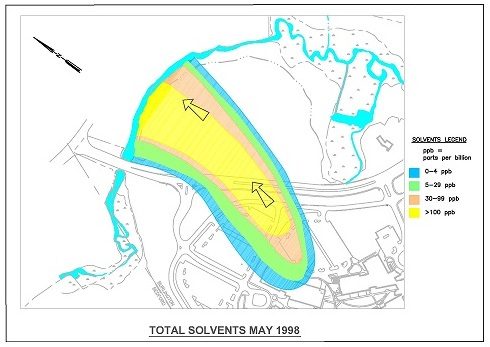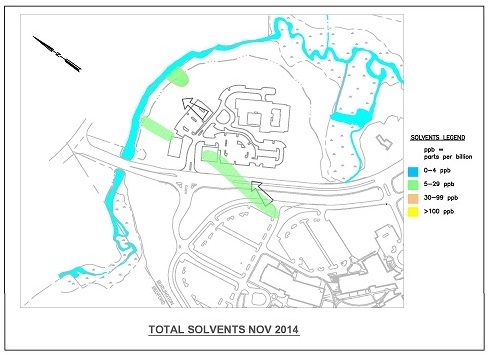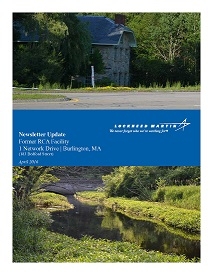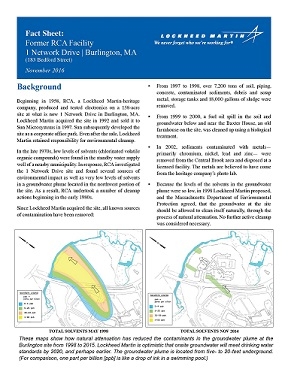History
Prior to 1995, a Lockheed Martin heritage company produced and tested electronics on a 158-acre site at what is now 1 Network Drive in Burlington, Massachusetts.
- In the late 1970s, low levels of solvents were found in the standby water supply well of a nearby municipality.
- The site was investigated and several sources of environmental impact were identified. Very low levels of chlorinated volatile organic compounds (solvents) were found in a groundwater plume located in the northwest portion of the site.
- A number of cleanup actions were undertaken beginning in the early 1980s to ensure human health and safety and protect the environment.
Cleanup
Lockheed Martin acquired the heritage company in 1995. Since then, all known sources of contamination have been removed.
- Over 7,200 tons of soil, piping, concrete, contaminated sediments, debris and scrap metal, storage tanks and 18,000 gallons of sludge were removed from 1997-1998.
- Because the levels of the solvents in the groundwater plume were so low, in 1998 Lockheed Martin proposed, and the Massachusetts Department of Environmental Protection (MassDEP) agreed, that the groundwater at the site should be allowed to clean itself naturally, through the process of natural attenuation. No further active remediation was considered necessary.
Public Involvement Plan
In 1998, responding to community concerns, the state of Massachusetts designated the site as a Public Involvement Plan (PIP) site under the Massachusetts Contingency Plan (MCP).
- The report for the groundwater plume noted that the contaminant levels in the plume are declining and that when they diminish to the point where they meet drinking water standards, Lockheed Martin will submit a Permanent Solution, which will document that the site has met all cleanup requirements under the Massachusetts Contingency Plan.
- At that time, an update will be provided to the Board of Health and the community to describe the results of the groundwater-monitoring program.
Today
The initial expectation in 2003 was that it could take 35 years for the groundwater to meet drinking water standards. Monitoring in later years revealed that the natural processes were proving more effective than anticipated.
- As a result, the site’s groundwater could meet drinking water standards faster than originally projected, perhaps as soon as 2020.
- Due to a new MassDEP standard, 1,4-dioxane is now a contaminant of interest in groundwater. Sampling will continue to ensure it is dissipating and that the new standards are being met.
- See the Burlington Newsletter Spring 2016 and Fact Sheet for more information.
The maps below show how natural attenuation has reduced the contaminants in the groundwater plume at the Burlington site from 1998 to 2015.

Lockheed Martin is optimistic that onsite groundwater will meet drinking water standards by 2020, and perhaps earlier. The groundwater plume is located from five- to 20-feet underground.
(For comparison, one part per billion [ppb] is like a drop of ink in a swimming pool.)

If You Have Questions, Please Contact Corporate Communications at 800.449.4486
Community Information
If you have questions, please contact Lockheed Martin Communications.
lm.communications@lmco.com
800.449.4486
Burlington Fact Sheet November 2016
Timeline
- Late 1970s - Low levels of solvents were found in the standby water supply well of a nearby municipality
- 1995 - Lockheed Martin acquired the heritage company that operated on the site.
- 1997 -The site was sold to Sun Microsystems
- 1997 and 1998 - 7,266 tons of soil, piping, concrete, sediments, debris and scrap metal, storage tanks and 18,000 gallons of sludge were removed
- 1998 - Lockheed Martin proposed, and the MDEP agreed, that the groundwater at the site should be allowed to clean itself naturally, through natural attenuation
- 1998 - The state of Massachusetts designated the site as a Public Involvement Plan (PIP) site
- June 2000 - Lockheed Martin's public involvement activities won a Silver Anvil award from the Public Relations Society of America
- March 2003 - Phase IV Final Inspection Report and Completion Statement was completed
- March 2003 - Partial Response Outcome Statement was completed
- March 2003 - Phase V Monitoring Report and Remedy Operations Status Statement was completed
- June 2013 - Phase V Monitoring Report & Five Year Review was completed.
- June 2018 – Phase V Remedy Operations Status Report and Five-Year Review was completed.
View a list of terms commonly used in relation to general environmental remediation efforts that can be found throughout this Web site.





